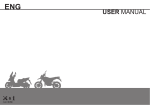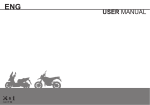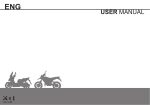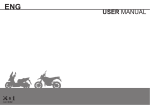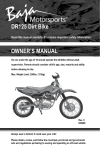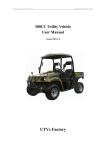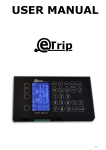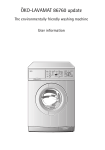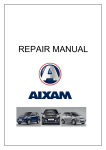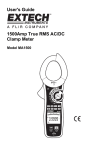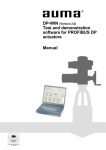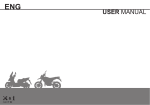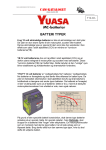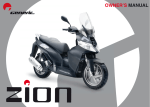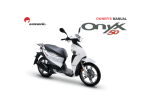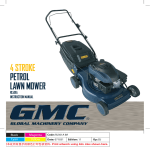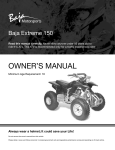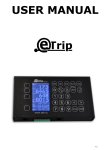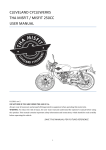Download Code User manual
Transcript
ENG mod.# K 69 USER MANUAL INTRODUCTION Thanks for your purchasing of this vehicle. This model is designed for safety, built for durability, and perfected for daily street use. The unique vehicle design, enrich of stylish and peronality, represents your outstanding taste and favor to pursue the state of the art living attitude. This manual describes the correct usage of this motorcycle including safety riding, simple inspection methods and so on. For a more comfortable and safety riding, please read this manual carefully. If any questions concerning the operation or maintenance of your vehicle, please consult a dealer. 1 IMPORTANT MANUAL INFORMATION In this manual with some important information is distinguished by the following notations: ! WARNING CAUTION It is WARNING instructions that need to follow, failure of follow coulnd be end in result severe injuiry or lead to death to the operator. A CAUTION indicates with special precautions to avoid damage to the vehicle. CAUTION • Please always put this manual with vehicle for rider maintenance/ dealer tracking of service records even if vehicle is being sold. • This manual contains the most of the vehicle information, however, the maker will continually imrprove it’s product design and quality that lead to difference between the manual and vehicle . If you have any questions concerning this manual, please consult your dealer. ! WARNING FOR YOUR OWN SAFETY, PLEASE READ THIS MANUAL CAREFULLY BEFORE OPERATION THIS Vehicle. ONLY OPERATE THE Vehicle UNTIL YOU HAVE COMPLETELY AWARE OF ADEQUATE KNOWLEDGE OF CONTROLS AND OPERATION FEATURE AND YOU HAVE BEEN TRAINED IN SAFE AND PROPER RIDING TECHNIQUES. PERIODIC INSPECTIONS, WELL MAINTENANCE AND GOOD RIDING SKILLS, WILL ENSURE YOUR SAFETY RIDING AND INCEASE THE PRODUCT RELIABILITY OF THIS VEHICLE. *Product and specifications are subject to change without notice. 2 IMPORTANT MANUAL INFORMATION Dealer label here 3 TABLE OF CONTENTS INTRODUCTION 1 IMPORTANT MANUAL 19 OPERATION AND IMPORTANT INFORMATION 2 TABLE OF CONTENTS 4 SAFETY INFORMATION Other safe-riding points Location of label Side view 5 7 8 9 DESCRIPTION OF THE VEHICLE Controls and instruments Pre-operation check list 9 10 INSTRUMENT AND CONTROL FUNCTIONS Main switch Dashboard unit Handlebar switches - left Handlebar switches - right Brake pedal Shift lever Steering lock Fuel Cock Fuel tank cap Fuel Catalytic converter Side stand Main stand Tools 11 11 11 12 13 14 14 14 15 15 16 16 17 17 17 PRE-OPERATION CHECKS 18 RIDING POINTS Starting the engine Stop the Engine Starting off Shifting and riding Acceleration and deceleration Braking Engine break in Parking 20 20 20 20 21 21 21 22 22 PERIODIC MAINTENANCE AND MINOR REPAIR Owner’s tool kit Spark plug Engine oil Petrol filter Air cleaner Carburetor Idling speed Throttle cable free play Clutch adjustment Tires Rims Brake free play Brake pads Brake fluid Cables 4 23 24 24 25 26 26 27 27 27 27 28 29 29 30 31 31 Side stand Main stand Front fork Steering Wheel bearings Drive chain Shock absorber Battery Fuse Lighting 31 32 32 32 33 33 34 34 35 36 TROUBLESHOOTING Troubleshooting Troubleshooting chart 37 37 38 CLEAN AND STORAGE Clean the vehicle Storage 39 39 40 SPECIFICATIONS 41 CONSUMER INFORMATION 43 WARRANTY INFORMATION 44 MAINTENANCE SCHEDULE 45 SERVICE PLAN 46 WIRING DIAGRAM 47 SPACE FOR NOTES 48 SAFETY INFORMATION THIS VEHICLE ARE TWO WHEEL SINGLE TRACK VEHICLES. THE USE OF SAVETY AND OPERATION MAY IN DIFFERENT RESULT BY THE USE OF PROPER RIDING TECHNIQUES OF THE OPERATOR. TO REMIND OF OPERATOR, WHO SHOULD KNOW THE FOLLOWING REQUIREMENTS BEFORE RIDING. HE OR SHE SHOULD: • WELL TRAINED AND FIMILIAR TO ALL THE ASPECTS OF Vehicle OPERATION. • FULLY READ AND AWARE OF MAINTENANCE REQUIREMENTS THAT NOTED IN THIS OWNER’S MANUAL. • OBTAIN QUALIFIED TRAINING & LEGAL LICENSE FOR OPERATION OF THIS VEHICLE. • WELL AND PROFESSIONAL MAINTENANCE SERVICE FOR OPERATOR AND CERTIFICATED REPAIR SHOP/DEALER TO ACQUIRE GOOD MECHANICAL CONDITIONS OF VEHICLE. Safe riding • Always pre-check your vehicle before riding is key point to prevent an accident. • Please follow the maxium loads limited of operator and passenger. • Most of accident on the motorists is cased by automobile driver who “failure to recognize out the vehicle” and caused mobile/vehicle accidents. Therefore, to make yourself conspicuous apprear to public will be very effective in reducing the change of this kind of accidents. Therefore: • Wear a brightly colored and protective clothes/Jacket • Operate the turning signals before turning and slow down the Speed when approaching and passthrough the intersection • Keep proper distance with other Motorists, and let them aware of your location • Know your skills and limits • Never lend your vehicle to oththers 5 who not qualified for riding • Always follow the legal speed limit on the vehicle and traffic law • The posture of the operator and passenger is important for proper control. properly riding posture can Keep vehicle in balance while riding. • Operator should sit up-right with two hand hold on handle bar, foot on floorboard while driving. • Passenger should make sure that he/she can firmly hold on grip or operator with foot step on footrest. • Drving after Acohol drink or other illegal drugs is strickly prohibited. • This vehicle is designed for onroad use only. It is not suitable for off-road use. Protective clothing Properly clothing yourself will keep you safety from potential accidents: • Always wear an approved helmet. • With face shield to protect your eye from dust and rain drop. • The wear of proper jacket, shoes, groves etc., can be better protection, SAFETY INFORMATION reducing the degree of injuiry from un-expected accident. • Never wear loose-fitting clothes, otherwise they could catch on the control levers or wheels and cause injury or an accident. • Never touch the engine or exhaust system during or after operation. They become very hot and can cause burns. Always wear protective clothing that covers your legs, ankles, and feet. Modifications Modifications made to this vehicle that not approved by maker, or the removal of original equipment, may let vehicle unsafe for use and cause severe personal injury. Modifications may also make your vehicle illegal touse. Loading and accessories Adding accessories or cargo to your vehicle may cause the different on the weight distribution of vehicle and influence on the steering & balance. It may cause possibility of an accident, please extremely caution and follow below limitation when you equipped with accessories. Below are some general or accessories. Here are some guidelines to follow if loading cargo or adding accessories to your vehicle. Loading The total weight of the operator, passenger, accessories and cargo must not exceed the maximum load limit. Maximum load (not include the vehicle): 150kg When loading within this weight limit, keep the following in mind: • Cargo and accessory weight should be kept as low and close to the vehicle as possible. Make sure to distribute the weight as evenly as possible on both sides of the vehicle to minimize imbalance or instability. • Make sure that accessories and cargo are securely attached to vehicle before riding • Never attach any large or heavy items to the handlebar, front fork, or front fender. Such items can create unstable handling or a slow steering response. 6 Accessorries Genuine accessories have been specifically designed for use on this vehicle. If need, please contact with dealer for detail. Since the maker can not test all other accessories , you must personally be responble for the proper selection, installation and use of non-OEM accessories. Keep the following guidelines in mind, when mounting accessories. • Never install accessories or carry cargo that would influence on the ground clearance, limit suspension travel, steering,or obscure lights or turning lights, reflectors. • Accessories on the handle bar/front suspension area will cause bad influence on steering the vehicle. if you will install accessories, please keep it as light in weight and not interfere on steering the vehicle. This vehicle is for On-Road transportation purpose only, please do not install any of extended cargo carrier as sulky, that will make vehicle unstable in cross winds and vehicle turns. • While equip with electrical acces- SAFETY INFORMATION sories, please consult with qualifiled stores, to make sure such items will not exceed the capacity of the vehicle’s electrical system. Unproper install of such items may cause a dangerous loss of lights, lower engine power or even damage the vehicle. king the vehicle, please note the following: • The engine and exhaust system remain hot, therefore, park the vehicle in a place where pedestrians or children are not likely to touch these hot areas. • Do not park the vehicle on a slope or soft ground, otherwise it may fall over. • Do not lay your vehicle to near flammable place. Gasoline and exhaust gas • GASOLINE IS HIGHLY FLAMMABLE: • Always turn the engine off when refueling. • In case of swallow any gasoline, or • Take care not to spill any gasoligasoline get into your eyes, please ne on the engine (hot) or exhaust see your doctor immeidately. Keep system when refueling. away the gasoline to your skin and • Do not smoke or use Mobile phowater. ne while re-fueling. • Never start the engine or let it run for any length of time in a closed area. The exhaust fumes are poisonous and may cause loss of consciousness and death within a short time. • Always turn the engine off before leaving the vehicle and remove the key from the main switch. When par- 7 OTHER SAFE-RIDING POINTS • Turn the signal before making turns. • When raining or across on run on the wet road, Iron Plates, keep your speed low, slightly using braking to avoid slipping or even fall down. • Be careful when passing parked cars. A driver might not see you and open a door in your path. SAFETY INFORMATION LOCATION OF LABEL 1. Label, anti-tampering 1 Symbol image 8 DESCRIPTION OF THE VEHICLE SIDE VIEW 1. Front wheel 2. Front disc brake 3. Headlight 4. Front turn signal light 5. Horn 6. Spark plug 7. Clutch pedal 8. Fuel tank cap 9. Battery 10. Seat 11. Main stand 12. Side stand 13. Pedal 14. Rear disc brake 15. Tail/brake light 16. Rear turn signal light 17. Rear wheel 5 8 10 13 4 15 3 16 1 2 6 9 7 9 11 12 14 17 DESCRIPTION OF THE VEHICLE CONTROLS AND INSTRUMENTS 18. Left handlebar switches 19. Clutch lever 20. Fuel gauge 21. Speedometer 22. Right handlebar switches 23. Front brake lever 24. Throttle grip 25. Main switch 26. Rear brake pedal 27. Clutch pedal 18 19 20 27 21 23 24 26 25 10 22 INSTRUMENT AND CONTROL FUNCTIONS MAIN SWITCH Main switch lock (1) On the supplied key´s is lockated one additional allen key for locking the ignition lock. 1 The main switch controls the ignition and lighting systems. The various positions are described as below. On All electrical circuits are supplied with power, the engine can be started. The key cannot be removed. ! WARNING Never turn the key to or , while the vehicle is moving, otherwise the electrical systems will be switched off, which may result in loss of control or an accident. Make sure that the vehicle is stopped before turning the key. DASHBOARD UNIT 2 3 4 5 8 9 10 11 12 6 7 1 Off All electrical systems are off . The key can be removed. 11 1.Rev counter 2.Fuel gauge 3.Neutral indicatro lamp N 4.Turn signal indicator lamp 5.Clock 6.Gear indicator 7.High beam indicator lamp 8.Odometer / Tripmaster indicator 9.Odometer / Tripmaster display 10. Speedometer 11. ADJ - Button 12. SEL - Button Rev counter Displays the engine speed in RPM. Fuel gauge Displays how much fuel remains in the fuel tank. The fuel gauge indicates the amount of fuel in the fuel tank. The needle moves towards “E” (Empty) as the fuel level decreases. When the needle reaches “E”, refuel as soon as possible. CAUTION Be take care not let the fuel tank to fully INSTRUMENT AND CONTROL FUNCTIONS empty it-self, that cause engine can not run it-self anymore. Neutral indicator lamp (N) Lights up whenever neutral (N) is selected. Odometer / Tripmaster indicator Indicates whether you have currently selected the odometer or the tripmaster. Turn signal indicator lamps The relevant indicator lamp flashes whenever you activate the turn signals. Clock Displays the time of day. Odometer / Tripmaster display Displays total distance travelled or the trip meter (Tripmaster). Tripmaster: Displays the trip meter. The Tripmaster is reset by pressing the ADJ button for 3 seconds. Please note that this function is available only when the TRIP function is active. Gear indicator Indicates which gear is currently engaged. In neutral (N), no light is lit. ADJ - Button Toggles the display between km/h and mph or resets the Tripmaster to 0. High beam indicator light This indicator light comes on when the high beam of the headlight is switched on. SEL - Button Toggles between main odometer and trip meter. Pressing and holding the SEL button enables you to set the time. Using SEL, select the hour or second figure and adjust the value using ADJ. Speedometer Displays the current speed. 12 HANDLEBAR SWITCHES - LEFT 4 1 6 3 2 5 1.Clutch lever 2.Light switch / 3.Turn signal switch 4.Head light flasher 5.Horn button 6.Choke Clutch lever Pulling the clutch lever in disconnects the transmission from the engine. Light switch By toggling the position of the switch, you can change between main beam and dipped beamt . INSTRUMENT AND CONTROL FUNCTIONS Turn signal switch By changing the position of the switch, you can indicate left or right . With the switch in the centre position, the turn signals are switched off. Head light flasher As log as this button is pressed the high beam is on. Horn button Sounds the horn. Choke Twisting opens or closes the choke. HANDLEBAR SWITCHES - RIGHT 1 3 6 2 4 5 1.Engine - ON / OFF 2.Light switch / / 3.Electric starter switch 4.Front brake 5.Throttle grip 6.Lever adjustment Engine - ON / OFF By toggling the position of the switch, you can switch the engine on and off . Caution when starting the vehicle. Light switch / / Change the switch position to select lights OFF , position lights and nor13 mal lights . Caution, control illumination, main beam, dipped beam and rear light function only in the latter switch position. Electric starter switch Pull the clutch lever in and press the electric starter switch to start the vehicle. Caution, operate the starter for no more than 5 seconds. CAUTION At the same time you have to pull the right brake lever to start the vehicle. For starting the vehicle read the notes in manual. Front brake Pull to operate the front brake. Throttle grip Twist back to increase throttle and forwards to reduce throttle. Lever adjustment You can adjust the lever distance to INSTRUMENT AND CONTROL FUNCTIONS suit your needs. Push the lever forward slightly and turn the screw in the desired positions of the four, this must be on the lever opposite the arrow symbol. Position 1 is the longest and the shortest distance position 4. SHIFT LEVER The foot-operated gear lever (1) is located on the left side of the vehicle. The vehicle is equipped with a 5-speed manual transmission. BRAKE PEDAL The brake pedal (1) is located on the right-hand side of the vehicle and operates the rear brake. Familiarise yourself with how it works before you ride the vehicle on public roads. Novices and returning riders are recommended to take a riding techniques course. 1 STEERING LOCK 1 To rule out the risk of serious damage or injury, you should familiarise yourself with this type of transmission before you start the vehicle. CAUTION Never attempt to change gear without releasing the clutch. Novices and returning riders are recommended to take a riding techniques course. 14 The steering lock (1) is located on the front right of the steering head between the two fork bridges. To use it, it is necessary to turn the handlebars to the left, insert the ignition key, press the key down gently and turn it to the right. CAUTION To rule out the risk of a serious accident, disengage the steering lock before you start the vehicle. INSTRUMENT AND CONTROL FUNCTIONS 1 event, turn the petrol tap to the RES position. If you need to do this, visit a filling station at the earliest opportunity to refuel. Open the fuel tank cap (1) Fold up the lock cover (2). Insert the ignition key into the lock (3) and turn it a quarter turn clockwise. The closure cap can be unlocked and opened rearward. FUEL COCK 1.▪ OFF No petrol can flow from the fuel tank to the carburettor. Always turn the petrol tap to the OFF position as soon as you have parked the vehicle. 2. ON Turn the petrol tap to this position before you attempt to start the vehicle. Petrol flows from the fuel tank to the carburettor. 3. RESERVE Irregular vehicle behaviour is often caused by a lack of fuel. In this 1 CAUTION After refuelling, always turn the petrol tap back to the ON position. FUEL TANK CAP The fuel tank cap (1) is located on the upper side of the vehicle. 15 Close the fuel tank cap (1) In reverse order. INSTRUMENT AND CONTROL FUNCTIONS 2 1.Fuel tank filler tube 2.Fuel level 3 Make sure that there is sufficient fuel in the tank. Fill the fuel tank to the bottom of the filler tube as shown. ! WARNING CAUTION Make sure that the fuel tank cap is properly closed and locked before riding. • Do not overfill the fuel tank, otherwise it may overflow when the fuel warms up and expands. • Avoid spilling fuel on the hot engine. CAUTION Immediately wipe off spilled fuel with a clean, dry, soft cloth, since fuel may damage the painted surfaces or plastic parts. FUEL 1 2 Regular unleaded gasoline only. Recommended fuel: 95 oct 17l +/- 0.5l !!CAUTION!! BIOETHANOL E10 IS NOT SUITABLE 16 CATALYTIC CONVERTER This model is equipped with a catalytic converter in the exhaust system. ! WARNING The exhaust system is hot after operation. Make sure that the exhaust system has cooled down before doing any maintenance work. CAUTION The following precautions must be observed to prevent a fire hazard or other damages. • Use only unleaded gasoline. The use of leaded gasoline will cause unrepairable damage to the catalytic converter. • Never park the vehicle near possible fire hazards such as grass or other materials that easily burn. • Do not allow the engine to idle too long. INSTRUMENT AND CONTROL FUNCTIONS SIDE STAND MAIN STAND TOOLS The tools are located under the side cover (1). It allows you to perform minor work. With the vehicle you also get a tool kit for minor repairs. 1 1 The side stand (1) is located on the left side of the Vehicle. Release the sidestand by using your feet to step on the bracket of side stand to up-right position to stand the vehicle. The main stand (1) is located on the left side of the Vehicle. Release the sidestand by using your feet to step on the bracket of side stand to up-right position to stand the vehicle. CAUTION CAUTION • The side stand with auto-rebound system. Make sure your vehicle have been park well are stable enough to stand the vehicle. • Please avoid to use side stand to park the vehicle on the slope, soft land or un-flat ground. • The main stand with auto-rebound system. Make sure your vehicle have been park well are stable enough to stand the vehicle. 17 1 PRE-OPERATION CHECKS The condition of a vehicle is the owner’s responsibility. The operator should check the vehicle by simple but thorough inspection,to make sure of vehicle condition, quick inspect some key and important parts, to prevent the vehicle from serious consquence/accident. Please carefully check the following points before each ride. CAUTION Pre-operation checks should be made each time the vehicle is used. Such an inspection can be accomplished in a very short time; and the added safety it assures is more than worth the time involved. ! WARNING If any item in the Pre-operation check list is not working properly , have it inspected and repaired before operating the vehicle. If failed to be corrected by yourself, please turn to repair shop immediately. If failed to be corrected by yourself, please turn to repair shop immediately. 18 PRE-OPERATION CHECKS PRE-OPERATION CHECK LIST CHECKPOINT TO VERIFY Fuel • • • Check fuel level in fuel tank. Refuel if necessary. Check fuel line for leakage. Engine oil • • • Check oil level in oil tank. If necessary, add recommended oil to specified level. Check vehicle for oil leakage. Final transmission oil • Check vehicle for oil leakage. Front brake • • • • • • • Check operation. If soft or spongy, have dealer bleed hydraulic system. Check brake pads for wear. Replace if necessary. Check fluid level in reservoir. If necessary, add recommended brake fluid to specified level. Check hydraulic system for leakage. Rear brake • • • • • • • Check operation. If soft or spongy, have dealer bleed hydraulic system. Check brake pads for wear. Replace if necessary. Check fluid level in reservoir. If necessary, add recommended brake fluid to specified level. Check hydraulic system for leakage. Throttle grip • • • Make sure that operation is smooth. Check cable free play. If necessary, have dealer adjust cable free play and lubricate cable and grip housing. Wheels and tires • • • Check for damage. Check tire condition and tread depth. Check air pressure. Brake levers • • Make sure that operation is smooth. Lubricate lever pivoting points if necessary. Main stand / Side stand • • Make sure that operation is smooth. Lubricate pivot if necessary. Chassis fasteners • • Make sure that all nuts, bolts and screws are properly tightened. Tighten if necessary. Instruments, lights, signals and switches • • Check operation Correct if necessary 19 OPERATION AND IMPORTANT RIDING POINTS ! WARNING • Before riding the vehicle, please make sure that you are fully fimiliar with all operating controls & their functions before riding. To consult a dealer shop if you not thoroughly understand. • Please do not start the engine in a closed area, the exhaust air are poisonous, and inhaling them can cause loss of consciousness and even death in short time. STARTING THE ENGINE CAUTION Note the point „Engine break in“ before you start to riding the vehicle. again. Each starting process should be as short as possible in order to save battery and the starter. STOP THE ENGINE 1.Reduce the throttle to 0 position. 2.Pull the clutch lever 3.Switch the gear to neutral N 4.Operate the brakes 5.After the vehicle is stopped turn off the ignition. 1 CAUTION 1.Turn on the ignition . 2.Switch the gear to neutral N 3.Actuating one of the brakes 4.Operate the starter button (1) without accelerating 5.Let the side stand raise up CAUTION • The engine starts immediately upon actuation of the starter, then wait a few seconds before you try to start it 20 Before starting off allow the engine to warm up otherwise the spark plug and engine can be damaged early. STARTING OFF 1.Pull the clutch lever 2.Shift the engine to the first gear 3.Slowly release the clutch lever and open the throttle at the same time. OPERATION AND IMPORTANT RIDING POINTS SHIFTING AND RIDING a) Shifting gears upwards 1.Release the throttle 2.Pull the clutch lever 3.Lift the gear lever upwards to change to the higher gears. 4.Slowly release the clutch lever and open the throttle at the same time. ACCELERATION AND DECELERATION The speed can be adjusted by opening and closing the throttle. To increase the speed, turn the throttle grip in direction (a). To reduce the speed, turn the throttle grip in direction (b). b) Shifting gears downwards 1.Release the throttle 2.Operate the brakes and reduce the speed to a appropriate speed. 3.Pull the clutch lever 4.Lift the gear lever down wards to change to the lower gears. 5.Slowly release the clutch lever and open the throttle at the same time. ! WARNING Always switch one gear only, otherwise the transmission can be damaged. BRAKING 1.Release the throttle. 2.Apply the front and rear brake at the same time. 3.Apply the clutch lever gradually increasing the pressure. 21 ! WARNING • Avoid hard or sudden braking (especially when cornering) otherwise the motorcycle may skid. • Railroad crossings, street-car rails, iron plates on road construction sites, and manhole covers become extremely slippery when wet. • Keep in mind that braking on a wet road is much more difficult • Ride downhill slowly because braking downhill can be very difficult. • When you brake, the brake discs, brake pads and the brake flid heat up. The hotter these parts get, the weaker the braking effect. In extreme cases the entire braking system might malfunction. • Take time to become familiar with the braking system. OPERATION AND IMPORTANT RIDING POINTS ENGINE BREAK IN Since the engine is brand new, do not put an excessive load on it for the first 1000 km. The various parts in the engine wear and polish themselves to the correct operating clearances. During this period, prolonged full-throttle operation or any condition that might result in engine overheating must be avoided. CAUTION If any engine trouble should occur during the engine break-in period, immediately have a dealer check the vehicle. 6.Lower the side stand with your foot while holding the motorcycle upright. Remove the key from the main switch. ! WARNING Since the engine and exhaust system can become very hot, park in a place where pedestrians or children are not likely to touch them. Do not park on a slope or on soft ground, otherwise the vehicle may overturn. beim Parken einen sicheren Stand hat. PARKING 1.Reduce the throttle to 0 position. 2.Pull the clutch lever 3.Switch the gear to neutral N 4.Operate the brakes 5.After the vehicle is stopped turn off the ignition. 22 PERIODIC MAINTENANCE AND MINOR REPAIR CAUTION Most of the Safety and condition of vehicle depend on how you do the correct maintenance , periodic inspection, adjustment and lubrication. The following are contents that help the operator to do such skills on the following pages. ! WARNING Maintenance, replacement, or repair of the emission control devices and systems may be performed by any repair shop or individual that is certified and must follow the local law regulations. If you are not familiar with maintenance work, have a dealer do it for you. 23 PERIODIC MAINTENANCE AND MINOR REPAIR OWNER’S TOOL KIT SPARK PLUG With the vehicle you also get a tool kit for minor repairs. The service information included in this manual and the tools provided in the owner’s tool kit are intended to assist you in the performance of preventive maintenance and minor repairs. However, additional tools such as a torque wrench may be necessary to perform certain maintenance work correctly. The spark plug is an important engine component, which is easy to check. Since heat and deposits will cause any spark plug to slowly erode, the spark plug should be removed and checked in accordance with the periodic maintenance and lubrication chart. In addition, the condition of the spark plug can reveal the condition of the engine. CAUTION If you do not have the tools or experience required for a particular job, have a dealer perform it for you. Remove the spark plug 1.Remove the spark plug cap 2.Remove the spark plug, with the spark plug wrench included in the owner’s tool kit. 3.Check that the porcelain insulator (1) around the center electrode of the spark plug is a medium-to-light tan (the ideal color when the vehicle is ridden normally). The spark plug (1) is on the left front of the vehicle. 1 ! WARNING Modifications not approved by maker may cause loss of performance, excessive emissions, and render the vehicle unsafe for use. Consult a dealer before attempting any changes. Modifications without authorization of the manufacturer cause void the warranty. CAUTION 1 24 If the spark plug shows a distinctly different color, the engine could be operating improperly. Do not attempt to diagnose such problems yourself. Instead, have a dealer check the vehicle. PERIODIC MAINTENANCE AND MINOR REPAIR 2 Specified spark plug: NHSP LD - B7RC NGK - DR8EA wire thickness gauge and, if necessary, adjust the gap to specification. Clean the surface of the spark plug gasket and its mating surface, and then wipe off any grime from the spark plug threads. 6.Install the spark plug with the spark plug wrench, and then tighten it to the specified torque. Spark plug gap: 0,6 - 0,7 mm 0,6-0,7 mm 4.Check the spark plug for electrode (2) erosion and excessive carbon or other deposits, and replace it if necessary. ! WARNING Please note that no other spark plug model is allowed. Using a different spark plug model can immediately lead to engine damage. 5.Measure the spark plug gap with a ! WARNING Please note the max. torque when inserting the plug. If you do not have the ability to control you leave control of 25 the spark plug to the dealer. . Tightening torque: 12 Nm ENGINE OIL Use a high-quality engine oil and change it regularly to extend the life of your engine. Check the oil level at every refuelling stop and top up the oil in good time. To check the oil level, run the engine for a few minutes then switch it off and wait one minute: • Position the vehicle on its centre stand and check the oil level at the sight glass illustrated above. The oil level must be between the MAX (1) and MIN (2) marks. • In dusty, cold or poor road conditions, the condition of the oil deteriorates more rapidly. Oil changes should therefore be carried out more frequently. PERIODIC MAINTENANCE AND MINOR REPAIR Recommended engine oil: Castrol Power 1 Racing 4T 10W40 Full: 1,2 l / Change: 1 l 1 • Make sure that no oil gets on the tire or wheel. PETROL FILTER The petrol filter (1) is located directly next to the petrol tap underneath the fuel tank. Handling the petrol filter is hazardous as petrol may escape. Have the replacement carried out by the specialist dealer. regular intervals, especially if you ride the vehicle in very dusty and/or humid conditions. The air cleaner is located on the lefthand side of the vehicle behind the side cover. 1 2 2 Oil change The engine oil can be topped up whenever this is needed but oil changes and oil filter replacements should be carried out by the specialist dealer because failure to carry out this work correctly could result in engine damage. ! WARNING • Make sure that no foreign material enters the final transmission case. Remove screws (1), open cover (2). It is now possible to remove the air cleaner. The air cleaner should be cleaned dry or using only a specially formulated cleaning agent. If necessary, have the air cleaner exchanged by the specialist dealer. 1 AIR CLEANER CAUTION The air cleaner should be checked at 26 • Make sure that the air lter element is PERIODIC MAINTENANCE AND MINOR REPAIR properly seated in the air filter case. • The engine should never be operated without the air lter element installed, otherwise the piston and/or cylinder may become excessively worn. THROTTLE CABLE FREE PLAY 1.Release the locknut (1) 2.Rotate the adjusting screw (2) to adjust the clearance. 3.Tighten the lock nut (1) after adjustingthe nut (2). adjusting nut (3) in or out to meet the requirements of clutch free play. 3.The free play should be 10-20 mm on the clutch lever. 4.Tighten the lock nut (1) after adjusting the nut (2). CARBURETOR The carburetor is an important part of the engine and its emission control system, which requires very sophisticated adjustment. Therefore, carburetor adjustments should be left to dealer, who has the necessary professional knowledge and experience. IDLING SPEED If the idle is not correct consult a dealer to check it. The minimum speed of the engine (idling) must be approxemately 1600 ±100 rev/min. 2 1 1 The throttle cable free play should measure 1.5 ~ 3.5 mm at the throttle grip. CLUTCH ADJUSTMENT 1.Loosen the locknut (1) 2.Turn the adjusting bolt (2) and the 27 2 3 PERIODIC MAINTENANCE AND MINOR REPAIR TIRES To maximize the performance, durability, and safe operation of your vehicle, note the following points regarding the specifed tires. Tire air pressure The tire air pressure should be checked and, if necessary, adjusted before each ride. ! WARNING The tire air pressure must be checked and adjusted on cold tires (i.e., when the temperature of the tires equals the ambient temperature). The tire air pressure must be adjusted in accordance with the riding condition. If you are not familiar to this, please have dealer for help. Tire air pressure: Front: 2.1 bar - 2.5 bar Rear: 2.1 bar - 2.5 bar Total weight of rider, passenger, cargo and accessories! Maximum load*: 150 kg * Total weight of rider, passenger, cargo and accessories Tire inspection ! WARNING Do not over load your vehicle, since it will increase pressure on the tire, braking, steering than original design, and may could cause damge or even lead to accident. Allocation of your cargo and weight of your vehicle is very important for your own safety and vehicle performance. Load your cargo rmly on vehicle and put the heaviest cargo to the center of vehicle, then distribute the weight evenly from side to side. It will keep you to have good steering after load. 28 1 3 2 1.Tire tread depth 2.Tire sidewall 3.Tire wear indicator ! WARNING The tires must be checked before each ride. If a tire tread shows crosswise lines (minimum tread depth), if the tire PERIODIC MAINTENANCE AND MINOR REPAIR has a nail or glass fragments in it, or if the sidewall is cracked, have a dealer replace the tire immediately. DIMENSIONS TIRES/ RIMS Front: Rim: 2.5x17 Tire: 100/80-17 M/C CAUTION The tread depth may vary depending on country. Observe local regulations. The values listed here are technical values and may differ from the legal values of your region. Minimum tire tread depth: Front and rear: > 1,6 mm ! WARNING • Drive with worn tire is illegal, reduces stability and can lead to loss of control over the vehicle. • Let worn or damaged tires replaced immediately by your dealer. • Working tires and the dealer is responsible. Rear: Rim: 3.0x17 Tire: 130/70-17 M/C TYRE TYPE: tubless wheel must be replaced. • The wheel should be balanced whenever either the tire or wheel has been changed or replaced. An unbalanced wheel can result in poor performance, adverse handling characteristics, and a shortened tire life. • Ride at moderate speeds after changing a tire since the tire surface must first be “broken in” for it to develop its optimal characteristics. BRAKE FREE PLAY RIMS Front brake To maximize the performance, durability, and safe operation of your motorcyc- CAUTION le, note the following points regarding There should be no free play at the brathe specified wheels. ke lever end. If there is free play, have a dealer inspect the brake system. • The wheel rims should be checked ! WARNING for cracks, bends or warpage before each ride. If any damage is found, A soft or spongy feeling in the brake have a dealer replace the wheel. Do lever can indicate the presence of air not attempt even the smallest repair in the hydraulic system. If there is air to the wheel. A deformed or cracked in the hydraulic system, have a dealer 29 PERIODIC MAINTENANCE AND MINOR REPAIR bleed the system before operating the motorcycle. Air in the hydraulic system will diminish the braking performance, which may result in loss of control and an accident. Rear brake Brake padel free play 1.Loosen the locknut (1) 2.Turn the adjusting bolt (2) until the lever position is within specified position (10-20 mm free play on the lever) 3.Tighten the locknut again. BRAKE PADS The brake pads must be checked for wear at the intervals specified in the periodic maintenance and lubrication chart. CAUTION There should be no free play at the brake padal‘s end. If there is free play, have a dealer inspect the brake system. 1 2 ! WARNING A soft or spongy feeling in the brake padel can indicate the presence of air in the hydraulic system. If there is air in the hydraulic system, have a dealer bleed the system before operating the motorcycle. Air in the hydraulic system will diminish the braking performance, which may result in loss of control and an accident. ! WARNING After adjusting make sure that the break pads do not drag. When there is no free play on the lever the pressure in the brake system will increase and the system can overheat and fail. If proper adjustment cannot be obtained as described contact a dealer to make this adjustment. 30 Each brake pad is provided with wear indicators, which allows you to check the brake pad wear without having to disassemble the brake. To check the brake pad wear, check the position of the wear indicators while applying the brake. If a brake pad has worn to the point that a wear indicator almost touches the brake disc, have a dealer replace the brake pads as a set. PERIODIC MAINTENANCE AND MINOR REPAIR BRAKE FLUID ! WARNING Insufficient brake fluid may allow air to enter the brake system, possibly causing it to become ineffective. Before riding, check that the break fluid is above the minimum level mark (1) and refill it if necessary. ful chemical reaction and lead to poor braking performance. • Be careful that water does not enter the master cylinder when refilling. Water will significantly lower the boiling point of the fluid and may result in vapor lock. • Brake fluid may deteriorate painted surfaces or plastic parts. Always clean up spilled fluid immediately. • As the brake pads wear, it is normal for the brake fluid level to gradually go down. However, if the brake fluid level goes down suddenly, have a dealer check. CABLES The operation of all control cables and the condition of the cables should be checked before each ride, and the cables and cable ends should be lubricated if necessary. If a cable is damaged or does not move smoothly, have a dealer check or replace it. Recommended lubricant: Castrol Motorrad DWF oilspray ! WARNING Damage to the outer housing of cables may result in internal rusting and cause interference with cable movement. Re! WARNING place damaged cables as soon as posHave a dealer change the brake fluid sible to prevent unsafe conditions. at the intervals specified in the NOTE after the periodic maintenance and lubrication chart. SIDE STAND Changing the brake fluid 1 1 Recommended brake fluid: Castrol Super Disc Brake Fluid DOT 4 CAUTION • Refill with the same type of brake fluid. Mixing fluids may result in a harm- 31 The operation of the side stand should be checked before each ride, and the PERIODIC MAINTENANCE AND MINOR REPAIR pivots and metal-to-metal contact surfaces should be lubricated if necessary. ! WARNING If the side stand does not move up and down smoothly, have a dealer check or repair it. Recommended lubricant: Castrol Multi Purpose Grease MAIN STAND CAUTION The operation of the main stand should be checked before each ride, and the pivots and metal-to-metal contact surfaces should be lubricated if necessary. ! WARNING If the main stand does not move up and down smoothly, have a dealer check or repair it. Recommended lubricant: Castrol Multi Purpose Grease ! WARNING Recommended lubricant: Castrol Motorrad DWF oilspray ! WARNING • When damage to the fork, please contact your dealer. • If you treat the telescopic fork with cleaning agents, make sure that FRONT FORK they get no contact with the tires or the brakes. This can lead to dangeThe condition and operation of the front rous accidents. fork must be checked as follows at the intervals specified in the periodic maintenance and lubrication chart. STEERING Worn or loose steering bearings may cause danger. Therefore, the operati! WARNING on of the steering must be checked as Securely support the motorcycle so that follows at the intervals specified in the periodic maintenance and lubrication there is no danger of it falling over. chart. 1.Place the vehicle flat and upright 1.Place the vehicle on the center from. stand/suitable motorcycle stand to 2.Apply the front brake and push the raise the front wheel off the ground. handlebars several times down hard 2.Hold the lower ends of the front fork to verify the suspension of the fork. legs and try to move them forward and backward. 32 PERIODIC MAINTENANCE AND MINOR REPAIR 3.If any free play can be felt, have a dealer check or repair the steering. WHEEL BEARINGS The front and rear wheel bearings must be checked at the intervals specified in the periodic maintenance and lubrication chart. CAUTION If there is play in the wheel hub or if the wheel does not turn smoothly, have a dealer check the wheel bearings. DRIVE CHAIN Please note that the drive chain must be checked regularly before every ride. The drive chain free play (1) should be between 10mm and 20mm. Suitable care products are available from specialist dealers. CAUTION An inadequately maintained and poorly tensioned chain accelerates the rate of wear of the chain itself, the chain drive and the output pinion. 1 ! WARNING If the chain tension is too great, parts within the secondary power trasmission (chain, chain sprockets transmission and rear wheel bearings) will be subjected to unnecessary stress resulting in early wear and even chain breakage. Too much slack in the chain, on the other hand, can result chain jumping off the chain wheels. If this happens the chain could also block the rear wheel or damage the engine. In either case the operator is likely to lose control of the motorcycle. 33 Tensioning the chain drive 1.Loosen collar nut (2) 2.Loosen counter nuts (3) 3.Turn right and left adjusting screws (4) equally far. The drive chain free play (1) should be between 10mm and 20mm. 4.Tighten counter nuts (3) and the collar nut (2). Tightening torque of the collar nut (2): 70 Nm PERIODIC MAINTENANCE AND MINOR REPAIR BATTERY This model is equipped with a sealedtype (MF) battery, which does not require any maintenance. There is no need to check the electrolyte or to add distilled water. 1 2 3 4 SHOCK ABSORBER The shock absorber is equipped with a preload adjuster. The shock absorber‘s preload adjuster is infinitely variable. This allows the shock absorber to be adapted to match your body weight and the payload. ! WARNING Adjust the shock absorber To adjust the spring tension, place the vehicle on the main stand. • Turn the adjusting ring (1) clockwise to increase the preload • Counterclockwise to decrease the preload ! WARNING The shock absorber is filled with high density nitrogen. Do not disassembly the shock Absorber. This may lead to injury. 34 • Do not remove the battery vent seal, this can be dangerous, the battery permanently damaged. • Battery acid is poisonous and dangerous, it contains sulfuric acid and leads to dangerous burns. • Avoid skin, eye and clothing contac. Protect your eyes always when working near the battery. • Upon contact with the battery aicd, make immediate FIRST AID. • If skin or eye contact with battery acid, rinse the affected areas with plenty of water. • When accidentally swallowed battery acid drink large amounts of water. • In both cases, as soon as possible, see a doctor. PERIODIC MAINTENANCE AND MINOR REPAIR • Batteries develop explosive hydrogen gas. Keep open flames, smoking materials away from the battery and make sure there is adequate ventilation when you charge a battery indoors. • KEEP THIS AND ALL BATTERIES OUT OF THE REACH OF CHILDREN. • Fully charge the battery before installation. • After installation, make sure that the battery leads are properly connected to the battery terminals. To charge the battery Have a dealer charge the battery as soon as possible if it seems to have discharged. Keep in mind that the battery tends to discharge more quickly if the vehicle is equipped with optional electrical accessories. CAUTION To store the battery • If the vehicle will not be used for more than one month, remove the battery, fully charge it, and then place it in a cool, dry place. • If the battery will be stored for more than two months, check it at least once a month and fully charge it if necessary. Specified fuse: 15 Amp ! WARNING Do not use a fuse of a higher amperage rating than recommended to • Please contact your dealer if you are avoid causing extensive damage to not familiar with handling the battery. the electrical system and possibly a fire. ! WARNING • Always keep the battery charged. 3.Turn the key to and turn on the Storing a discharged battery can electrical circuits to check if the decause permanent battery damage. vices operate. 4.If the fuse immediately blows again, have a dealer check the electrical FUSE system. The fuse holder is located behind battery cover, behind the side cover. Replacing the fuse 1.Turn the key to and turn off all electrical circuits. 2.Remove the blown fuse, and then install a new fuse of the specified amperage. 35 PERIODIC MAINTENANCE AND MINOR REPAIR LIGHTING Front indicator Tail/Brake light and license plate If the turn signal light bulb does not com light on, remove the screw of the indicator lens (2) out and replace the bulb. Headlight bulbs 2 1 4 Rear indicators 5 3 CAUTION This model is equipped with halogen bulb headlight (1).If a headlight bulb burns out,have a dealer replace it and, if necessary,adjust the headlight beam. This model has furthermore a LED position light. If the LED position light defective, please contact your dealer. If the tail/brake light (4) and licenes light bulb (5) does not come on,have a dealer check its electrical circuit or replace the If the turn signal light bulb does not com bulb. on, remove the screw of the indicator lens (3) out and replace the bulb. 36 TROUBLESHOOTING TROUBLESHOOTING Although the vehicles receive a thorough inspection before shipment from the factory, trouble may occur during operation. Any problem in the fuel, compression, or ignition systems, for example, can cause poor starting and loss of power. The following troubleshooting chart represents a quick and easy procedure for checking these vital systems yourself. However, should your vehicle require any repair, take it to a dealer, whose skilled technicians have the necessary tools, experience, and knowhow to service the vehicle properly. Use only genuine replacement parts. Imitation parts may look like parts, but they are often inferior have a shorter service life and can lead to expensive repair bills. 37 TROUBLESHOOTING TROUBLESHOOTING CHART ! WARNUNG Keep away open flames and do not smoke while checking or working on the fuel system. 1. Fuel Check the fuel level in the fuel tank. Check the compression. Operate the electric starter. There is no fuel. Supply fuel. There is compression. Check the ignition. There is no compression. Have a dealer check the vehicle. The engine does not start. Check the compression. 2.Compression Operate the electric starter. 3.Ignition Remove the spark plug and check the electrodes. 4.Battery Operate the electric starter. Wet Dry Wipe off with a dry cloth and correct the spark plug gaps, or replace the spark plug. Have a dealer check the vehicle. Operate the electric starter. The engine does not start. Check the battery. The engine turns over quickly. The battery is good. The engine turns over slowly. Check the battery lead connections, and charge the battery if necessary. 38 The engine does not start. Have a dealer check the vehicle. CLEAN AND STORAGE CLEAN THE VEHICLE Clean of the vehicle in proper and suitable way will make it attractive, extend it’s lfe and optimize the performance. Before cleaning 1.Cover the muffler outlet with a plastic bag to prevent water to come . inside. Please do it only after the 2.Closed every caps, covers, electrical connectors that are well install and water can be avoid to get into, while you do the clean job. CAUTION • Do not use acid-based cleaners. If such funds used for stubborn stains, so use this only occasionally, dry it immediately after and then apply a corrosion protection spray. • Always follow the manufacturer‘s instructions on care and cleaning agents. • Use best only water and mild detergent or special cleaner from the dealer to the sensitive components of the vehicle to prevent damage. Dry the plastic parts then wipe with a soft, dry cloth or sponge. • Protect particularly plastic parts, paint, headlight glass from harsh chemicals such as fuel, rust remover, brake cleaner or similar. The use of such agents may result in malfunction, damage and affect the security itself. • Do not use a high pressure washer or steam cleaner, causing water in storage can penetrate electrical components such as connectors or switches, lighting, ventilation hoses, brake shoes and brake linings or damage, seals, paint and other surfaces. Cleaning after riding in the rain, near the sea or on salt-sprayed roads CAUTION Since sea salt or salt sprayed on the roads during winter are extremely corrosive in combination with water, carry out the following steps after each ride. • Wait until the engine / exhaust have cooled. • Clean the vehicle with warm water and a mild detergent. • Do not use hot water, which increases the corrosive effect of the salt. • Apply a corrosion protection spray on all metal, including chrome- and nickel-plated, surfaces to prevent corrosion. Cleaning after normal use Remove dirt with warm water, a mild de- After cleaning tergent, and a soft, clean sponge, and • Dry the vehicle. then rinse thoroughly with clean wa- • To prevent rust, we recommend apter. Use a toothbrush or bottlebrush for propriate care to use according to hard-to-reach areas. manufacturer‘s instructions. • Wax all painted surfaces. 39 CLEAN AND STORAGE Recommended Castrol care products: Greentec Bike Reiniger Bike Politur Motorrad DWF oilspray ! WARNING • Make sure that there is no oil or wax on the brakes or tires. • If necessary, clean the brake discs and brake linings with a regular brake disc cleaner and wash the tires with warm water and a mild detergent. • Before operating the vehicle, test the braking performance and tires. STORAGE Short-term (for a few days) • Always store your vehicle in a cool, dry place and, if necessary, protect it against dust with a vehicle cover. ! WARNING ! WARNING Please store the vehicle in a well air flow room with dry air if possible. A place with wet humidity will cause rust. Long-term (for weeks) • Clean the vehicle. • Drain the fuel from the carburetor. • Enter the drained fuel back into the fuel tank. • Fill the fuel tank to completely or add if necessary a fuel stabilizer to protect the fuel tank from rusting and the fuel from degradation. Follow the steps below to cylinders, piston rings, etc. to prevent rusting. • Remove spark plug cap and the spark plug. • Give a teaspoon of engine oil into the spark plug hole. • Join the Kickstarter to slow down and let the engine several times slowly rotate (thus the cylinder is oiled). • Put the spark plug back in and put on the spark plug cap. 40 To prevent damage or injury from sparking, make sure to ground the spark plug electrodes while turning the engine over. • Lubricate all control cables and the pivoting points of all levers and pedals as well as of the side stand/ main stand. • Check and, if necessary, correct the tire air pressure, and then lift the vehicle so that both of its wheels are off the ground. Alternatively, turn the wheels a little every month in order to prevent the tires from becoming degraded in one spot. • Cover the muffler outlet with a plastic bag to prevent moisture from entering it. • Remove the battery and fully charge it. Store it in a cool, dry place and charge it once a month. Do not store the battery in an excessively cold or warm place [less than 0 °C (30 °F) or more than 30°C (90 °F)]. SPECIFICATIONS DIMENSIONS ENGINE Engine type Air cooled 4-stroke Cylinder arrangement Forward-inclined single cylinder Displacement 124,5 cm³ / 148 cm³ Compression ratio 10.6:1 / 9.27:1 Starting system Electric starter Lubrication system Separate lubrication 4-stroke engine oil ENGINE OIL Quantity: 1.2 l recommended type: Castrol Power 1 Racing 4T AIR FILTER Wet element FUEL Unleaded gasoline only Capacity 17 +/- 0.5l CAUTION !! BIOETHANOL FUEL E10 IS NOT PERMITTED !! 41 CARBURETOR Manufacturer EXACT SPARK PLUG Manufacturer / model NHSP LD / B7RC NGK / DR8EA Spark plug gap 0.6-0.7 mm CLUTCH Clutch type Multiple plate clutch Transmission type 5-speed constant mesh transmission CHASSIS Frame type Steel tube backbone FRONT TIRE Rim: 2.5x17 Tyre: 100/80-17 M/C REAR TIRE Rim: 3.0x17 Tyre: 130/70-17 M/C SPECIFICATIONS TIRE AIR PRESSURE (COLD TIRES) Front: 2.1 bar - 2.5 bar Rear: 2.1 bar - 2.5 bar The selected tire pressure depends on the load! FRONT BRAKE Type Single Hydraulic disc brake 160mm Operation Right hand RECOMMENDED FLUID DOT 4 - CASTROL Super Disc Bremsflüssigkeit DOT 4 REAR BRAKE Type Single Hydraulic disc brake 260mm Operation Right food FRONT SUSPENSION Type Telescopic fork Spring/shock absorber type Coil spring/oil damper REAR SUSPENSION Type Unit swing Spring/shock absorber type Coil spring/oil damper ELECTRICAL SYSTEM Ignition system CDI Charging system CDI magneto BATTERY Model 12N7-4A Voltage, capacity 12 V, 7.0 Ah HEADLIGHT Halogen bulb BULB VOLTAGE, WATTAGE X QUANTITY Headlight 12 V, 35 W/35.0 W Tail/brake light 12 V, LED Front turn signal light 12 V, 10.0 W 42 Rear turn signal light 12 V, 10.0 W License plate light 12 V, 5.0 W Meter lighting 12 V, 2 W High beam indicator light 12 V, 2 W Neutral gear lamp 12 V, 2 W Turn signal indicator light 12 V, 3 W Horn 12 V, 3 A FUSES Main fuse 15.0 A CONSUMER INFORMATION IDENTIFICATION NUMBERS VEHICLE IDENTIFIKATION NUMBER (VIN) The vehicle identification number of the vehicle (1) is stamped on the steering head. Please write down the VIN (vehicle identification number) to order replacement parts from your dealer or the vehicle should be stolen. 1 CAUTION The vehicle identification number is used to identify your motorcycle and may be used to register your vehicle with the licensing authority in your area. 43 WARRANTY INFORMATION Please carefully read the instruction manual of your vehicle before operating it in order to make yourself familiar with its handling. We explicitly point out that the instruction, maintenance, and care instructions given in the operating manual have to be complied with in order to sustain your claim towards warranty. Only the strict compliance with customer specifications stated in the instruction manual ensures the prolonging of the natural life of your vehicle. Starting with the date of the invoice a limited warranty of 24 months is granted regarding the accuracy of the vehicle in terms of material and manufacturing according to latest standards. The legal warranty regulations will not be restricted by this limited guarantee. Maintenance work has to be exclusively done by authorized workshops entitled by us. Warranty in general is bound to the region of invoicing and can therefore only be carried out within the country the vehicle was bought. Damages that can be traced back to inappropriate usage, manipulation, or neglecting of the maintenance/care/operating instructions will not be covered by warranty. Warranty can only be granted if occurring damages are immediately being reported to the seller or any other authorized workshop by the buyer. The warranty claim entitles the buyer to remedy deficiencies or to the reparation respectively the exchange of a damaged part in an authorized workshop after our approval. Compensation for remote or instantaneous damages cannot be granted. Vehicles in desolate condition will not be covered by warranty. Repair works carried out on warranty do not enlarge the guarantee period. Only this document entitles you to call on warranty services. Therefore please make sure that you are delivered this fully filled in document by the seller and that he has registered your vehicle correctly in our system. Please also mind the following advices. Body and panelling of the vehicle have to be kept free of dirt constantly. Do not use high pressure water blasters, strong jets of water, sharp and corrosive or other aggressive detergents which could harm surfaces and varnish permanently and foster corrosion. It is vital to use protecting cleansers. Please consult our dealers for the right and appropriate products. Aluminium parts or other refined parts (chrome parts, anodized parts or other processed surfaces)have to be treated with appropriate maintenance products in order to prevent oxidation. Frame and metal parts are continuously to be treated with anticorrosive. A vehicle constantly parked outside has to be covered to avoid weathering and crack formations on seat and plastic parts. Vehicles used off-road and for racing purposes are excluded from warranty. Material which is to be used in the context of service and maintenance works are excluded from warranty as well as the following parts: incandescent bulbs, brake pads, clutch lining, filter elements, spark plugs, drive sprocket, wheel and axle., as well as the tires. 44 MAINTENANCE SCHEDULE The guarantee can be granted only if the vehicle has been serviced in accordance with this maintenance schedule. The inspection intervals are required, otherwise, no guarantee can be granted. 1000 km or 1. month 4.000 km or 6. month 7.000 km or 12. month 10.000 km or 18. month 13.000 km or 24. month PART TO DO Air filter Clean/ exchange √ √ Exchange √ √ Wheels, rims Control √ √ √ √ √ Tires Control/ tire pressure √ √ √ √ Wheel bearing Control/ exchange √ √ √ √ Steering bearing Control/ clean/ lubricate √ √ Lubricate √ Screws Coverparts Control/ tighten √ √ √ √ Brake system Control/ clean/ exchange √ √ √ √ Main stand Control/ clean/ lubricate √ √ √ √ Front forke Control √ √ √ √ Rear suspension Control √ √ √ √ Oil pump Control √ √ √ Transmission oil Exchange Variomatic belt Control/ exchange √ Exchange √ Fly wheels Control/ exchange √ Exchange √ Driven chain/ sproket Control/ clean/ exchange Clutch Control √ √ √ √ √ Cable/ bowden Control/ clean/ lubricate √ √ √ √ √ Throttle Control/ clean/ lubricate √ √ √ √ Lights/ switches Control/ adjust √ √ √ √ Fuel line/ fuel filter Control/ exchange Idle speed Control/ adjust Exhaust system Control/ tighten Coolant Control √ √ Exchange Exchange √ √ Exchange Exchange √ √ √ √ √ √ √ √ √ CAUTION: Variomatic belt, fly wheels, spark pluge, fuel filter and air filter element have to be exchanged every 7000km. Only use duration coolant. Brake lines have to be exchanged at least every 4 years. From 13.000km or 24th month the inspection should be made every 7000km. The vehicle is constantly checked for rust. The owner is responsible for rust prevention. 45 SERVICE PLAN The warranty can be granted only if the vehicle has been serviced in accordance with this service plan. 1000 km or 1. month 4000 km or 6. month Stamp / Signature Stamp / Signature 7000 km or 12. month 10000 km or 18. month Stamp / Signature Stamp / Signature 13000 km or 24. month 16000 km Stamp / Signature Stamp / Signature 19000 km 21000 km Stamp / Signature Stamp / Signature VEHICLE IDENTIFICATION NUMBER: NAME OF THE CUSTOMER: ......................................................................................................................................................................................................................................... MODEL: ....................................................................................................................................................................................................................................................................................... SIGNATION OF THE CUSTOMER: 46 ................................................................................................................................................................................................................................................................................................................................................................................................. ............................................................................................................................................................................................................................................................ WIRING DIAGRAM 47 SPACE FOR NOTES 48


















































